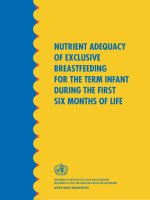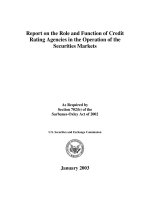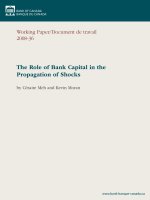The Simple Dollar Elements of Investing_7 potx
Bạn đang xem bản rút gọn của tài liệu. Xem và tải ngay bản đầy đủ của tài liệu tại đây (285.58 KB, 18 trang )
121
Keep It Simple
is a convenient way to obtain the broadest diversifi cation
in a single fund.
Investing in a Total World Stock Index Fund is a
convenient way to obtain the broadest diversifi ca-
tion in a single fund . . . like one - stop shopping.
Well-diversifi ed portfolios should have holdings of
bonds as well as stocks. Again, we believe that index funds
provide the most effi cient vehicle for individual investors
to hold bonds. On the opposite page, we list three bond
index funds that are suitable investments.
We believe that the funds listed here provide suitable
exposure to the stock and bond markets. They can easily
be purchased by calling the toll-free numbers listed or
by visiting the web sites.
Some investors will fi nd that exchange traded funds, or
ETFs, will be useful investment instruments. ETFs — most
are based on index funds — trade like individual stocks. The
two most popular ETFs are the QQQQs (or “ cubes ” ) that
track the NASDAQ 100 index and the “ Spyders ” (ticker
SPY, which explains the peculiar spelling) that track the
Standard & Poor ’ s 500 stock index. Neither of these ETFs
is as broad as we would like, but fortunately, new ones are
c05.indd 121c05.indd 121 11/3/09 10:16:22 AM11/3/09 10:16:22 AM
122
The Elements of Investing
now available that track total stock market indexes in the
United States and in the world.
The table on the opposite page shows the menu of ETFs
that we recommend. ETFs tend to have very low expense
ratios, and they can be more tax effi cient than mutual funds
because they are able to sell holdings without generating a
taxable event. This could be an advantage for taxable inves-
tors. However, brokerage commissions are charged on the
purchase of ETFs, and for small and moderate purchases
these commissions can overwhelm those other advantages.
No - load indexed mutual funds typically have no purchase
fees. However, if you are investing a lump sum (as, for
example, when rolling over an established plan such as an
IRA), an ETF may be an optimal choice.
The Vanguard Total World ETF (ticker VT) will give
you all the diversifi cation you need, over both domestic
and all international markets, with one - stop shopping.
c05.indd 122c05.indd 122 11/3/09 10:16:22 AM11/3/09 10:16:22 AM
123
Keep It Simple
Exchange Traded Funds (ETFs)
T icker E xpense R atio
Total U.S. Stock Market
iShares Russell 3000 IWV 0.20%
Vanguard Total Stock
Market
VTI 0.07%
Total World Ex - U.S.
Vanguard FTSE All World VEU 0.20%
SPDR MSCI ACWI CWI 0.34%
Total World Including U.S.
Vanguard Total World VT 0.29%
iShares MSCI ACWI ACWI 0.35%
Total Bond Market U.S.
Vanguard Total Bond
Market
BND 0.11%
iShares Barclays Aggregate AGG 0.20%
c05.indd 123c05.indd 123 11/3/09 10:16:22 AM11/3/09 10:16:22 AM
c05.indd 124c05.indd 124 11/3/09 10:16:22 AM11/3/09 10:16:22 AM
125
A SUPER
SIMPLE SUMMARY:
KISS INVESTING
T he steps to a comfortable care - free retirement are
really simple, but they require discipline and emotional
fortitude.
1. Save regularly and start early.
2. Use company - and government - sponsored retire-
ment plans to supercharge your savings and
minimize your taxes.
both1.indd 125both1.indd 125 10/31/09 1:33:40 PM10/31/09 1:33:40 PM
126
The Elements of Investing
3. Diversify broadly over different securities with
low - cost “ total market ” index funds and differ-
ent asset types.
4. Rebalance annually to the asset mix that ’ s right
for you.
5. Stay the course and ignore market fl uctuations;
they are likely to lead to serious and costly
investing mistakes. Focus on the long term.
KISS investing — Keep It Simple, Sweetheart — is the
best and easiest and lowest cost and worry - free way to
invest for retirement security. Go for it!
Speaking of sweethearts, all wives and all husbands
should be sure they both know all the facts about their
investments. And because we are each different in our
emotions about investments, markets, and money, fami-
lies should strive again and again to share their thoughts
and feelings so they can understand each other and make
decisions together.
both1.indd 126both1.indd 126 10/31/09 1:33:40 PM10/31/09 1:33:40 PM
127
APPENDIX:
SAVE ON
TAXES LEGALLY
B ecause the U.S. government wants to encourage us
to save more, a variety of retirement plans are avail-
able that allow individual taxpayers to deduct from
their federal taxes every dollar they save. Moreover,
these plans allow the earnings and gains from these
savings plans to compound over time tax free. Here
we describe the details of these tax-advantaged plans.
This section is, by necessity, more detailed and dryer
than most readers would like. You can skip it if you
bapp.indd 127bapp.indd 127 10/31/09 1:32:47 PM10/31/09 1:32:47 PM
128
*
These are the rules as of 2009; the dollar limits may well be raised in
subsequent years.
wish. Just make sure you are taking full advantage of at
least one of these plans. They not only permit you to
save more but also let the earnings from your savings
compound at a faster rate.
INDIVIDUAL RETIREMENT ACCOUNTS (IRAS)
The simplest form of savings and retirement plan avail-
able to everyone is the individual retirement account.
All people with earnings from employment can take
$5,000 a year ($6,000 if you are over 50 years of age)
and invest it in a mutual fund or other investment
vehicle. * If your income is moderate, you can deduct
the entire $5,000 from your taxable income. Thus, if
you are in the 28 percent tax bracket, the $5,000 con-
tribution really costs you only $3,600 because your tax
bill will go down by $1,400. Moreover, all the earn-
ings from that $5,000 investment will accrue tax free.
Wealthier individuals cannot get the same initial tax
deduction, but they do enjoy the benefi ts of the tax deferral
Appendix: Save on Taxes Legally
bapp.indd 128bapp.indd 128 10/31/09 1:32:48 PM10/31/09 1:32:48 PM
129
from the investment earnings on their IRA investment
account. The result is that the government subsidizes
your savings.
Now suppose that you have entered the workforce
at age 23 and that you invest $5,000 each year over a
45 - year period. Let ’ s further assume that you invest in
a broadly diversifi ed mutual fund earning 8 percent
per year. No taxes are paid on those earnings until you
withdraw the money during retirement. A person who
followed such a program of IRA savings would have a
fi nal value of over $2 million. The same savings with-
out the IRA benefi t (with all earnings taxed at a 28
percent rate) total only about $750,000. Even after
paying taxes at a 28 percent rate when you withdraw
your IRA contribution, you would end up with almost
$1.5 million, and you might be in a lower tax bracket
during retirement. The fi gure on page 130 shows
the dramatic advantage of investing through a tax -
advantaged plan.
You don ’ t have to win the lottery to be a millionaire.
Anyone with the will power to save regularly and start
early can become a millionaire.
Appendix: Save on Taxes Legally
bapp.indd 129bapp.indd 129 10/31/09 1:32:48 PM10/31/09 1:32:48 PM
130
ROTH IRAS
A type of IRA, called a Roth IRA, is available to sav-
ers whose income is below certain levels. (Any mutual
fund company can tell you if you qualify.) The tradi-
tional IRA lets you deduct your contribution from your
taxes immediately — in effect, giving you “ jam today. ”
The money gets taxed at retirement when you take
Appendix: Save on Taxes Legally
$2,000,000
$1,000,000
$0
1 5 9 13 17 21 25 29 33 37 41
$2,087,130
$755,512
Tax-Deferred Investing
Taxable Investing
Years
45
How Tax-Deferred Investing Grows Faster Than
Taxable Investing ($5,000 Invested per Year Earning
8 percent)
bapp.indd 130bapp.indd 130 10/31/09 1:32:48 PM10/31/09 1:32:48 PM
131
*
In 2010, conversions to a Roth IRA are allowed for all individuals,
regardless of income.
the accumulations out. The Roth IRA offers you “ jam
tomorrow. ” There is no upfront tax deduction, but when
you take the money out, you pay no taxes at all.
You are also allowed to “ Roth and Roll. ” You can roll
the balance of your traditional IRA into a Roth, again
if your income level qualifi es.
*
You need to pay tax on
the amount converted, but from then on neither the
earnings nor the withdrawals in retirement are taxed.
Moreover, you are not required to take the money
out at retirement, and contributions can continue to
be made into your seventies and eighties if you wish.
Thus, signifi cant amounts can be accumulated tax free
for future generations.
The decision of which IRA is best for you can be
tough. It depends on such things as whether your tax
bracket is likely to be higher or lower in retirement and
whether you have suffi cient funds in addition to your
IRA contribution to pay your income taxes. Most mutual
fund companies have “ Roth analyzers ” that are easy to
use. As a rule of thumb, if you are in a low tax bracket
now and you are far from retirement, you are very likely
Appendix: Save on Taxes Legally
bapp.indd 131bapp.indd 131 10/31/09 1:32:48 PM10/31/09 1:32:48 PM
132
to come out better with a Roth. And if your income is
too high to take a tax deduction on a traditional IRA, but
low enough to qualify for a Roth, a Roth is certainly the
correct choice since your contributions are made after tax
in any event.
PENSION PLANS
Retirement plans are available from most employers,
and the self - employed can set up their own plans. Most
employers now have 401(k) plans; educational institu-
tions have similar 403(b) retirement plans. These are
ideal savings vehicles because the money comes out of
your salary before you even see it and get tempted to
spend it. Even better, many employers match the sav-
ings you put in with company contributions so that
every dollar you save gets multiplied. As of 2009, you
can contribute $16,500 per year into such retirement
plans, and the contributions do not count as taxable
income. If you are over 50 and you need to play “ catch
up ” on your retirement savings, $22,000 per year can
be put into the plan.
Appendix: Save on Taxes Legally
bapp.indd 132bapp.indd 132 10/31/09 1:32:48 PM10/31/09 1:32:48 PM
133
Self - employed people from Avon ladies to doctors
can set up Keogh plans to which they can contribute
20 percent of their income up to $49,000 annually as
of 2009. Money paid into the plan is tax deductible,
and earnings from the investments are not taxed until
they are withdrawn. Even if you have a 401(k) plan
at your place of employment, moonlighting income
qualifi es for this additional plan. Mutual fund compa-
nies can help you prepare all the necessary paperwork,
as well as advise you on other similar self - directed
retirement plans.
By “ self - directed, ” we mean that you can choose
any mutual funds you like for the investment of
your retirement savings. These plans are a perfectly
legal way to checkmate the IRS. You will be making
a big mistake if you don ’ t save as much as you pos-
sibly can through these tax - sheltered means. If you
have any further questions about these plans, you can
get brochures from the IRS that cover all the detailed
regulations.
We understand that many people already struggling
to make ends meet will be unwilling or feel unable to
make the sacrifi ces necessary to take advantage of all the
Appendix: Save on Taxes Legally
bapp.indd 133bapp.indd 133 10/31/09 1:32:48 PM10/31/09 1:32:48 PM
134
opportunities available. Here ’ s how we believe you ought
to prioritize the available vehicles so that you build up
as much wealth as possible for your retirement years free
from worries about money.
First, contribute to your employer ’ s 401(k) or 403(b)
plan up to the limit that will be matched by your
employer. Thus, if your employer will match $5,000 of
your contributions, you get $10,000 of retirement sav-
ings when you contribute your $5,000 — double what
you put in yourself. Use up any other savings you have
for living expenses so you can contribute at least up to
the employer matching amount. When you consider
that these contributions are not taxed, you can easily
see that this is one of the few “ free lunches ” that will
ever be offered to you.
Second, contribute voluntarily up to the maximum
that is allowed in your 401(k) plan. Then start an IRA.
Even if you don ’ t get an immediate tax deduction, the
ability of your investment earnings to compound tax
free is an enormous benefi t, as the fi gure on page 130
makes clear.
You should know that there are some disadvantages
to these tax - advantaged retirement vehicles. You are not
Appendix: Save on Taxes Legally
bapp.indd 134bapp.indd 134 10/31/09 1:32:48 PM10/31/09 1:32:48 PM
135
allowed to withdraw money before age 59½, unless you
become disabled. If you do withdraw the funds early,
you must pay a penalty of 10 percent as well as appli-
cable income taxes. Moreover, any withdrawals will not
receive the benefi t of future tax-free compounding. You
have to keep the retirement kitty invested in the plan. In
our view, this is actually an important advantage of the
tax system because it so strongly encourages thrift and
staying the course. In this case, the tax system encour-
ages us to do something that is truly in our own best
interest.
TAX - ADVANTAGED SAVING
FOR EDUCATION
A variety of tax - advantaged plans provide incentives for
putting money aside for future education expenditures.
The most popular are the so - called 529 College Savings
Accounts. These accounts allow parents and grandpar-
ents to give gifts to children that can be invested for
future qualifi ed higher-educational purposes. The plan
allows an individual donor to contribute up to $55,000
into a 529 plan. No gift taxes need be paid and estate - tax
Appendix: Save on Taxes Legally
bapp.indd 135bapp.indd 135 10/31/09 1:32:48 PM10/31/09 1:32:48 PM
136
*
Comprehensive information on 529 and other education savings
plans can be found at />credits are not affected. All the earnings from the invest-
ments in the plan compound tax free. Two parents can
contribute $55,000 each, and if there are four well - off
grandparents, as much as $330,000 can be contributed
to junior ’ s college education. Even with tuitions rising
rapidly, the 529 plan, with investment earnings untaxed,
can make even the most expensive private college
comfortably affordable. If you have kids or grandchil-
dren and can afford to contribute, the 529 plan is an
attractive no - brainer.
Some pitfalls to these plans need to be considered. If
the funds are not used for qualifi ed expenditures, with-
drawals are subject to both income taxes and a 10 percent
penalty tax. Some of these plans carry very high expense
ratios, so be an educated consumer and shop around to
fi nd a low - expense plan.
These plans are sanctioned by individual states, and
some states (such as New York) allow you to take a
tax deduction for at least part of your contribution. If
your state does, too, fi nd a specifi c plan sanctioned by
your state. * Finally, if you are establishing a plan for
Appendix: Save on Taxes Legally
bapp.indd 136bapp.indd 136 10/31/09 1:32:48 PM10/31/09 1:32:48 PM
137
a teenager, for whom college is only a few years away, you
may well want the money invested in a short - term bond
fund. Money that will be needed for expenditure fairly
soon should not be invested in the stock market.
Appendix: Save on Taxes Legally
bapp.indd 137bapp.indd 137 10/31/09 1:32:48 PM10/31/09 1:32:48 PM
bapp.indd 138bapp.indd 138 10/31/09 1:32:48 PM10/31/09 1:32:48 PM









